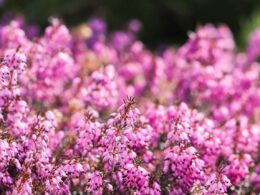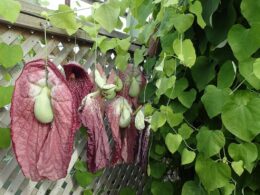In this article, we will provide you with a guide on how to plant and care for a mallow flower. We will also include some tips on how to get the most out of these beautiful blooms. So read on to learn more!
Mallow Flower – Morphology
The mallow flower (Malva sylvestris) is a member of the Malvaceae family and is native to Europe, Africa, and Asia. It has a distinctive morphology, with a five-petaled calyx and a five-lobed corolla. The petals of the flowers are usually white, but can also be pink or purple. The mallow flower is a popular choice for gardens and bouquets, due to its showy flowers, long blooming period, and similarity to the beautiful hibiscus and hollyhock blooms.
The mallow flower typically blooms in the summer months, from June to August. It is a hardy plant and can tolerate a wide range of growing conditions. This plant is annual, meaning it will die off after one growing season. However, the seeds of the mallow flower can be perennial (remain viable for several years).
There are many mallow species out there, and one of them, Althaea officinalis, were used to produce the first marshmallows. The plant’s root is recognized to have been used by ancient Egyptians to help cure coughs and sore throats, as well as heal wounds. The first marshmallows were made by boiling shredded root pulp in honey until thick.
Planting a Mallow Flower. Soil & Sunlight Needs
Mallow flowers need full sun to partial shade and well-drained soil. If you have heavy clay soil, add some organic matter to the planting area before you plant. Mallow also tolerates poor soil and drought conditions once it’s established.
To plant a mallow, dig a hole that’s twice as wide as the plant’s root ball. Place the plant in the hole and backfill with soil, tamping it down gently as you go. Water well to settle the soil around the roots. Mulch around the plant to help keep the roots cool and moist.
Planting a Mallow Flower. Watering and Fertilizing
Mallow flowers are lovely, delicate blooms that make a great addition to any garden. They come in a variety of colors, including white, pink, purple, and red. If you’re thinking about planting mallow flowers in your garden, here are a few tips to help you get started.
When it comes to watering, the mallow flower is pretty drought-tolerant. They don’t need a lot of water to thrive, so you can let the soil dry out in between watering. However, if you live in an area with very hot summers, you may want to water your mallow flowers a bit more often to keep them from wilting.
As for fertilizing, a mallow flower don’t need a lot of extra nutrients. A light feeding once or twice a year is all they need to stay healthy and bloom beautifully.
Are Mallow Plants Edible?
Mallow plants are a type of herbaceous plant that belongs to the Mallow family. Mallow plants are found in many parts of the world, including Europe, Asia, and Africa. The leaves, flowers, and fruits of mallow plants are all edible. Mallow leaves can be eaten raw or cooked, and the flowers can be used to make tea. Mallow plants are a good source of vitamins A and C, as well as iron and calcium. However, remember not to consume any wild plants without a proper identification and making sure it is safe.
Mallow: Common Pests and Diseases
Mallow flowers are susceptible to a number of pests and diseases. Common pests include aphids, caterpillars, slugs, and snails. Diseases that can affect mallow include powdery mildew, leaf spot and root rot. To prevent pests and diseases from becoming a problem, it is important to keep the plant well-watered (but not over-watered) and to remove any dead or dying leaves or flowers. Regular applications of an all-purpose fertilizer will also help to keep the plant healthy. If pests or diseases do become an issue, treatment with an insecticide or fungicide may be necessary.


















